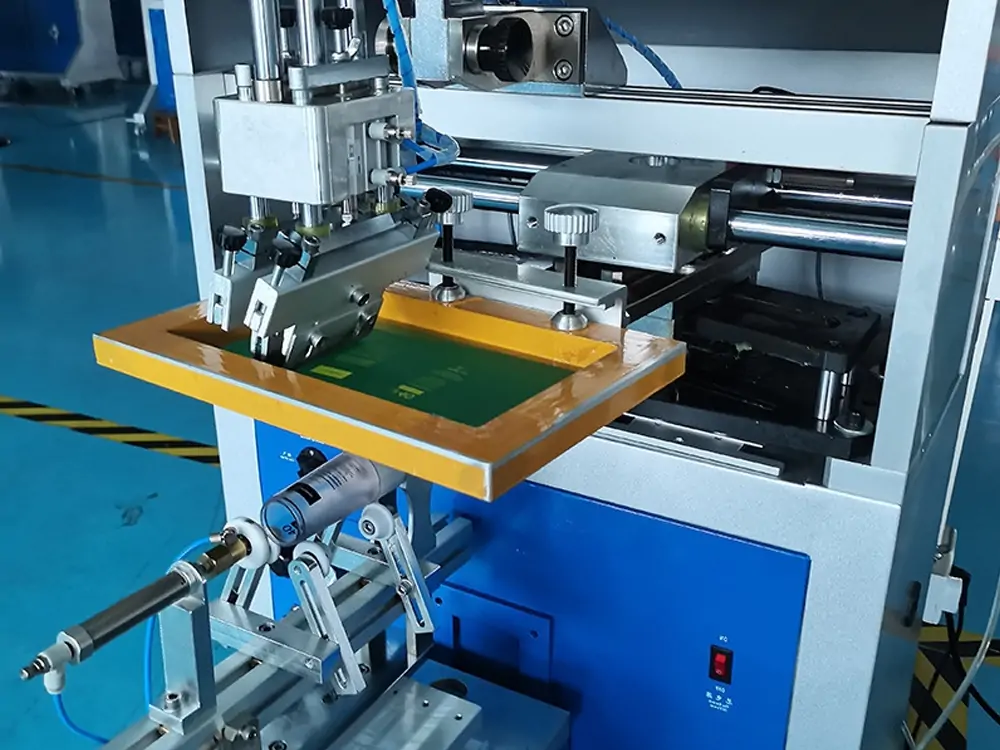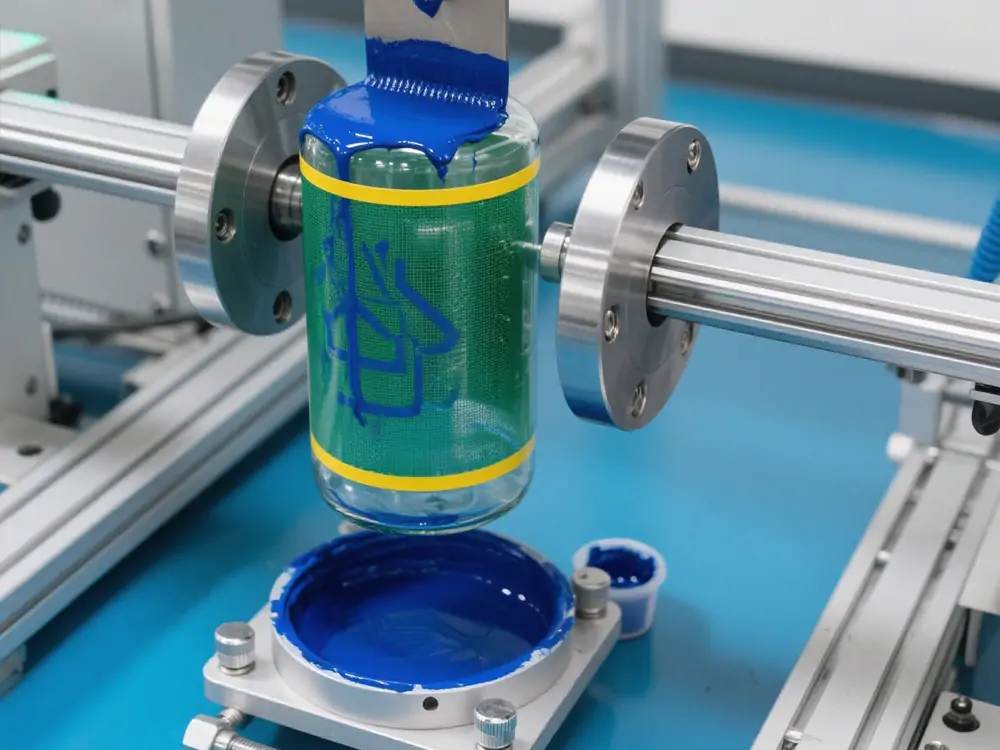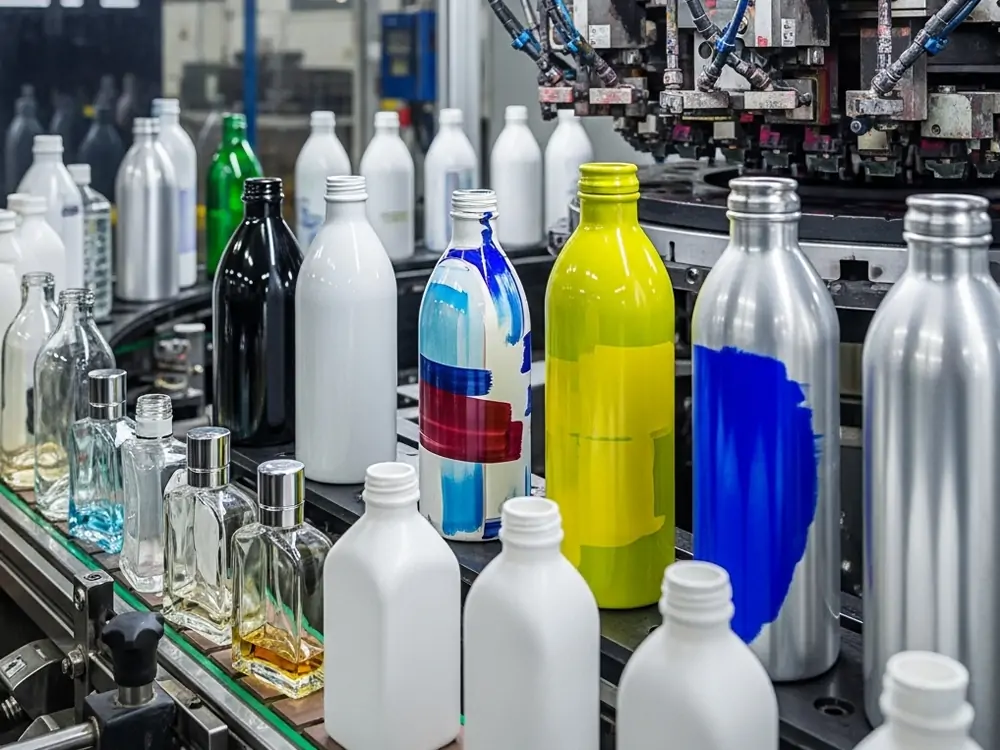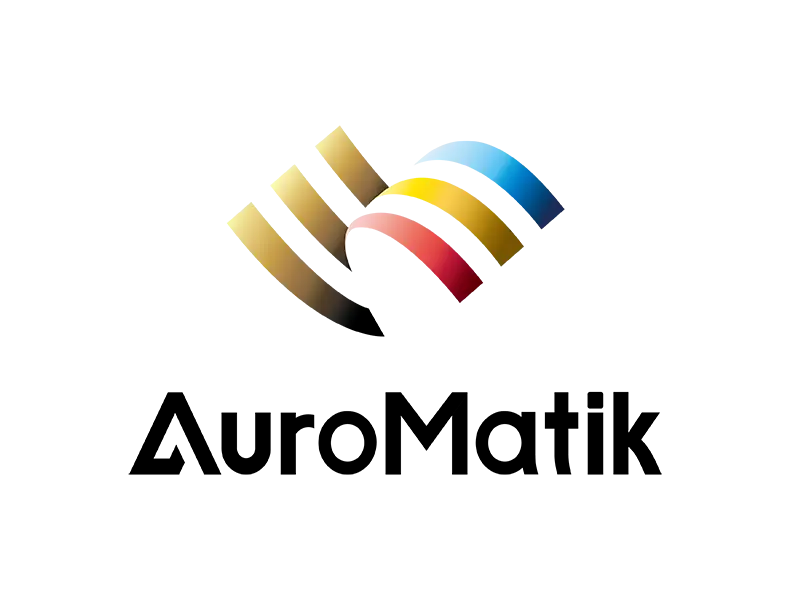According to sources, over 500 billion bottles are made each year, many of which are marked with logos, printed labels, or safety details.
If your business is in the cosmetics, beverages, chemicals, or pharmaceuticals industry, then bottling and printing are crucial not only for branding but also for regulatory and tracking purposes.
This is where round bottle screen printing shines. This method is made for round bottles. Ink is applied to a mesh screen, and as the bottle spins, it moves through the screen, resulting in a sharp, full print. This method is faster and much more useful than hand printing.
If you are still operating by hand or with entry-level tools, it is time to level up. A fully built screen printer allows for better and steadier control, faster results, and higher output, all with ease. With the right setup, printing on plastic, glass, or metal becomes simple.
This guide will take you through the full process of round bottle screen printing, including the necessary tools, surface preparation, and the best inks to ensure you achieve the best results. So, let’s begin.

What is Round Bottle Screen Printing?
Round bottle screen printing is a way of printing designs straight on round bottles. You place a mesh screen on the bottle, which is then placed on a spindle driver. The screen is lifted, and with the inkwell filled, the squeegee is lowered. The squeegee then forces ink through the mesh. As the bottle spins, the squeegee pushes ink on the screen, and the ink is transferred evenly.
This method works on round surfaces and is the type of printing commonly used on round bottles. Flat screen printing is still, meaning the object stays in place, and ink is applied from above. It works on flat surfaces but not well on round bottles.
Pad printing does not show full details and can only give limited full-circle coverage. In this printing method, a design is transferred to the surface using a silicone pad.
If you want to print text, logos, or designs around the bottle, you can use the round-bottle screen-printing method. It is fast, precise, and steady. For this reason, many makers use this method on plastic, glass, and metal bottles.
Types of Round Bottle Screen Printing Machines
| Types | Operation Mode | Ideal | Pros | Cons |
|---|---|---|---|---|
| Manual | Hand-operated | Low printing load | Low cost | High effort |
| Semi-Automatic | Partly automatic | Medium load | Good for the price | Some skill needed |
| Fully Automatic | Fully machine-run | High output | Fast, steady printing | High price |
Material Considerations for Bottle Printing
Before printing, it is essential to understand the surface on which you will be working.
For example, the use of ink on plastic, glass, and metal differs due to their unique properties. These materials, including metal, glass, and plastic, tend to be smooth and non-absorbent.
Because of this, getting ink to stick is often hard. Without proper surface preparation, printing may fail. It can peel, smear, or break off.
Let’s explore:
- Plastics such as PET, PE, and PP are examples of materials with low surface energy. For these, the ink will sit on top instead of sticking.
- Glass is often smooth and may have oil or dust residue from the manufacturing and handling process.
- Metals such as aluminum and stainless steel are smooth. They may have leftover grease, rust, or dirt from earlier steps that would stop ink from sticking.
Pretreatment Methods
It is important to treat each material properly if you want strong prints that last. Below is a short overview:
| Material | Pretreatment | Purpose |
|---|---|---|
| PET, PE, PP | Flame treatment, Corona treatment | Improve surface energy for better sticking |
| Glass | Washing, Heat coatings | Remove oils and make an ink-friendly surface |
| Aluminum, Steel | Cleaning, Plasma treatment | Remove dirt and help the ink stick better |
To get the best results, match the surface you want to print on with the right treatment. This is a crucial aspect of enhancing print quality and prolonging print longevity.

Inks and Curing Methods
To achieve clean prints, you must select the correct ink and the optimal drying method. Based on the bottle’s material, each ink type works in its own way. Therefore, using the correct drying method and matching the surface is crucial.
Types of Inks Used
UV-curable printing inks are very fast and reliable. UV inks cure immediately on exposure to UV light without moisture. In high-speed printing, there is no risk of smudging. In short, they are resistant to scratches and moisture. They are used in the packaging of cosmetics, pharmaceuticals, and foods.
Solvent-based inks are used in printing on PET and PE, and they work well on these materials. Solvent-based inks are also known to emit powerful odors, which necessitate proper airflow in the room where they are used to ensure safe use.
Inkjet thermal printing is done on PET plastic and works well on it. They are best used in metal bottles and are sure to work after heat drying. They require the bottles to be passed through an oven to set the ink.
Curing Technologies
Use this table to choose the right drying setup for each ink type.
| Ink Type | Curing Method | Equipment Needed |
|---|---|---|
| UV Ink | UV Lamp | UV Drying Unit |
| Solvent Ink | Air drying / IR Heat | Heat Dryer / Air Blower |
| Thermal Ink | Heat Tunnel | Oven or Heat Press |
Take your time to choose both the ink and the drying method correctly. The effect on the quality and life of the prints would be huge.
Machine Configuration & Setup
Setting the screen printer for round bottles is an important step toward achieving clear, consistent prints. Focus on the key parts first in the order they will be used.
The rotary holder is the part that holds and rotates the bottle during printing. It should match the printer’s and screen’s motion smoothly. The screen frame and mesh will also control the flow of ink. It is essential to select the appropriate mesh count for your ink type and design details. Fine meshes are good for detailed graphics, while lower counts are better for heavy ink deposits.
The squeegee system should also be checked. The squeegee’s material, angle, and pressure will affect the quality of the printing process. For uneven surfaces, a softer squeegee will work better; for smooth surfaces, a larger angle will work better. The ink tray must not only maintain the ink at the proper temperature, but also allow for overflow to ensure consistent prints.
All-around printers need special attention to setup. It is essential to match the screen width with the bottle width, then record changes in speed, stroke length, and squeegee angle. In multi-color jobs, layers should be precisely aligned using sensor-based alignment.

Printing on Different Bottle Types
This type of printer can print on many types of bottles, including:
Plastic Bottles (PET, HDPE, LDPE)
- Preheat bottles slightly to improve ink adhesion.
- Use flexible mesh screens for deformable surfaces, such as LDPE.
- Reduce squeegee pressure to avoid bottle distortion.
- Choose UV-curable inks for fast curing and durability.
- Use solvent-based inks if bottles are untreated, but ensure proper ventilation.
Glass Bottles
- Use anti-static devices or grounding to reduce static during printing.
- Select a hard mesh screen for better image definition.
- Use a firm squeegee blade to maintain print accuracy.
- Apply UV-curable inks for strong adhesion.
- Post-bake printed bottles at low temperatures to lock in the ink.
Metal Bottles (Aluminum, Steel)
- Secure bottles with proper fixtures to handle curved surfaces.
- Apply bonding agents or primers to prevent ink flaking.
- Use epoxy-based or thermal-curing inks for strong, lasting prints.
- Ensure that curing is performed using heat tunnels or ovens to achieve proper bonding.
- Ideal for outdoor, industrial, or high-wear applications.
Common Printing Challenges & Solutions
| Issue | Cause | Solution |
|---|---|---|
| Ink smudging | Incorrect curing or ink overload | Adjust ink deposit, improve curing time |
| Misalignment | Improper registration | Calibrate sensors and adjust fixtures |
| Poor adhesion | Inadequate surface energy | Use appropriate pretreatment |
| Ink cracking | Incompatible ink-substrate combo | Switch to flexible or UV ink |
Quality Control & Post-Processing
- Perform visual inspection to check for smudges, misalignment, or incomplete prints.
- Conduct adhesion testing using the cross-hatch test to ensure the durability of the ink.
- Use a densitometer to measure and verify color density and consistency.
- Apply post-curing (heat or UV) for solvent-based or thermal inks to ensure full curing.
- Use automated defect detection systems (camera-based) for real-time quality checks in high-volume runs.
Final Thoughts
Round bottle screen printing provides a reliable method for printing on plastic, glass, and metal bottles. However, to achieve high-quality results, you must follow each step carefully. Start by preparing the surface properly. Without pretreatment, your prints may peel or fade.
Next, choose the right ink. Match it to the material and curing method. Don’t guess—test it first. Set up your machine correctly. Adjust the mesh, squeegee, and rotation to fit your bottle type.
Also, don’t forget curing and quality control. Cure your prints fully and inspect every batch. If you’re printing in high volumes, use automated systems to catch defects early.
When you combine the right tools with the right process, you get clean, durable prints every time. Take your time, follow best practices, and avoid cutting corners. That’s how you move from trial and error to consistent, professional printing.
FAQs
Can You Print Multi-Color Designs on Round Bottles?
Yes, using multi-station printers with sensor-based registration ensures accurate color alignment.
What’s the Average Cost of a Semi-automatic Round Bottle Printer?
It ranges from $3,000 to $10,000, depending on features, speed, and build quality.
Which Pretreatment Method Is Best for Polypropylene Bottles?
Flame treatment is most effective for improving surface energy and ink adhesion on PP bottles.
Looking to invest in a high-quality glass printing machine? Contact Us now.
